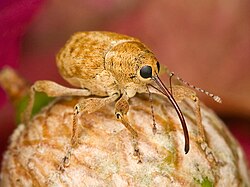Ecology
The female Curculio occidentis lays small batches of two to four eggs in a developing acorn. The resulting larvae feed on the kernel and when fully developed, tunnel out of the nut, fall to the ground and dig themselves a small chamber. They may wait one or two years before pupating. [4] Garry oak acorns were collected in 1996, 1997 (low crop years) and in 1998 (high crop year) to examine infestation damage. It was concluded that levels of infestation did not vary with crown level during the low crop years but varied during the high crop year. Affected acorns were more present at the lower portion of the tree than the upper part of the tree during the high crop year. [5]
Together with larva of the filbertworm moth (Cydia latiferreana), the filbert weevil feeds on the acorns of several species of oak tree. In British Columbia, up to 66% of acorns from garry oak (Quercus garryana) were infected with these larvae. These acorns are still able to germinate, but the germination rate is lower than for uninfected nuts. [2]
This page is based on this
Wikipedia article Text is available under the
CC BY-SA 4.0 license; additional terms may apply.
Images, videos and audio are available under their respective licenses.
